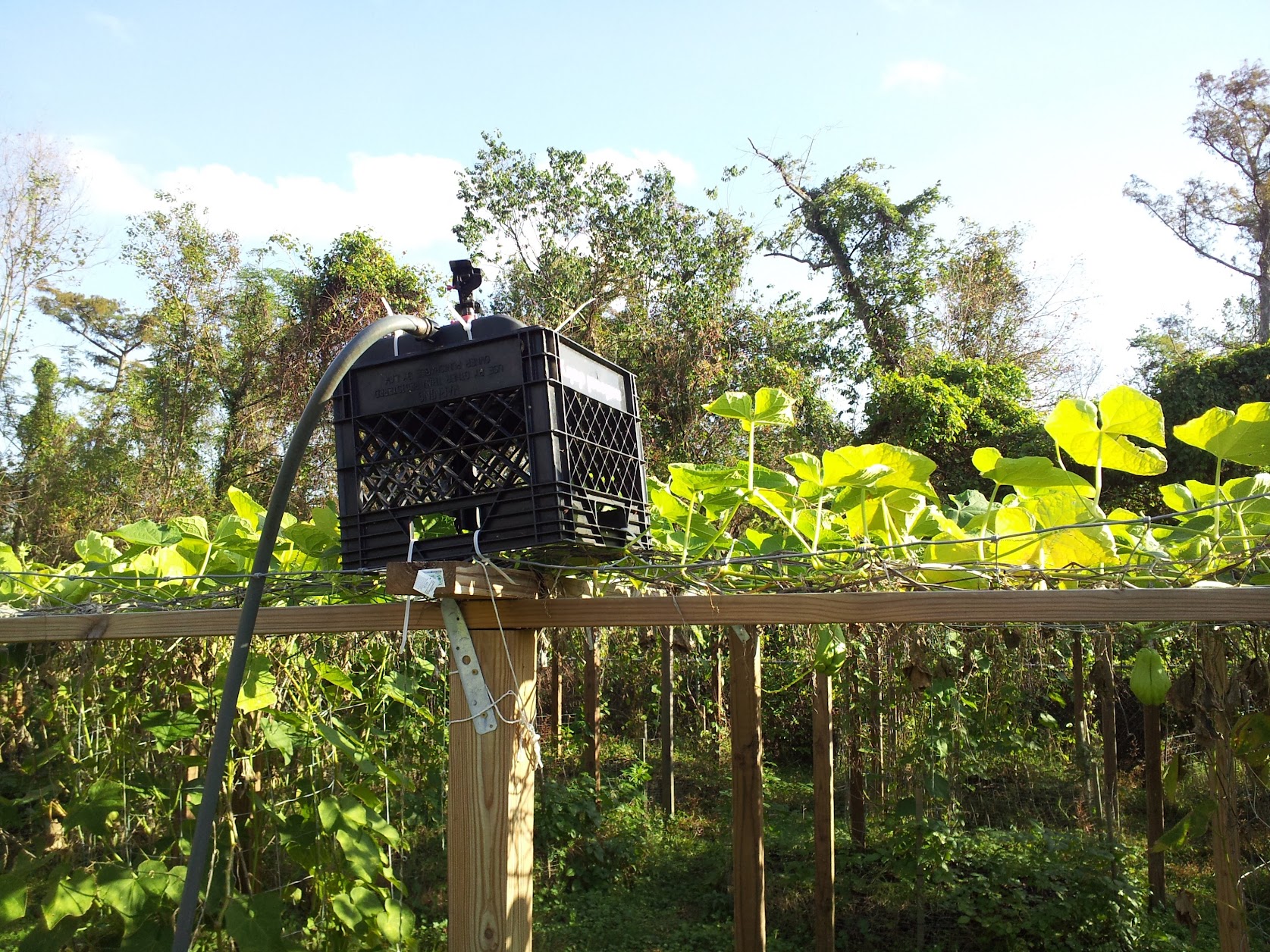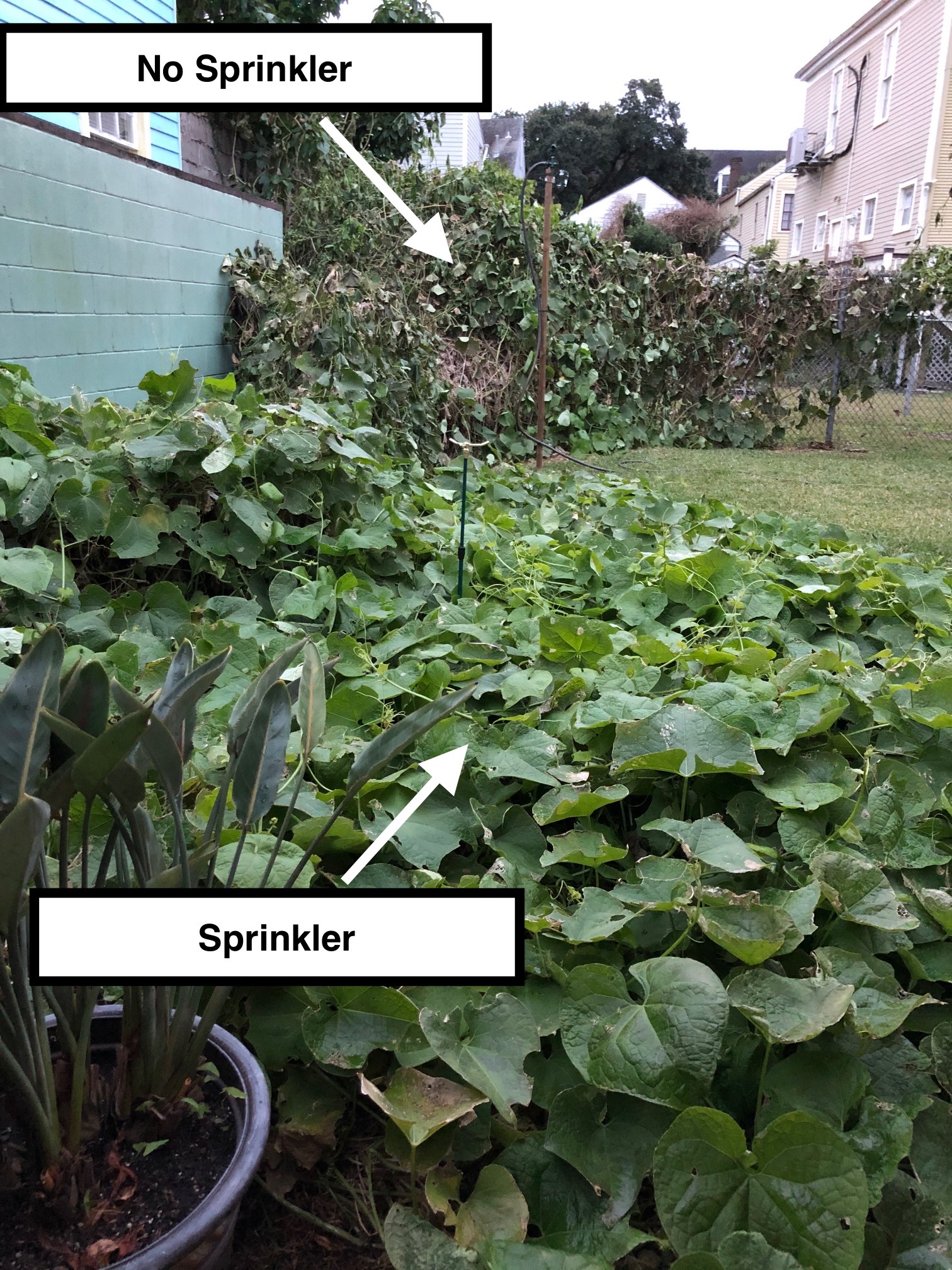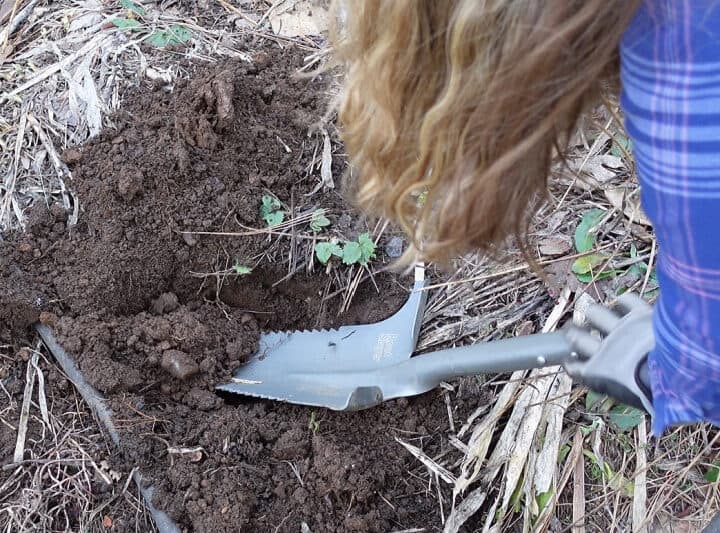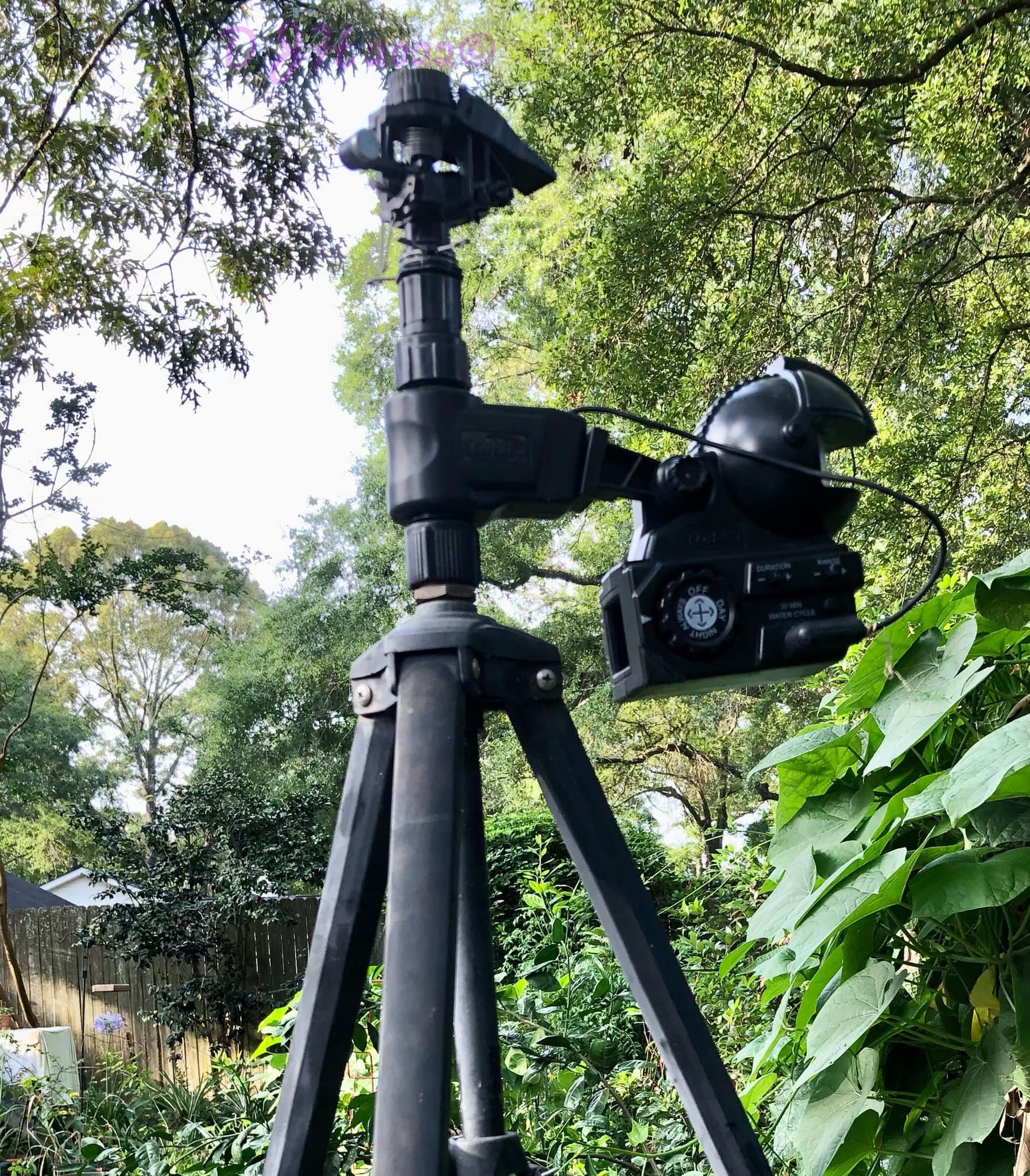by Lance Hill | Sep 1, 2022 | How To, Mirliton

Mirliton vine the day after a frost that was protected with a rotary sprinkler. The vine is healthy and ready to produce.

A damaged portion of the same vine that was beyond the reach of the sprinkler.
No one wants to nurse a mirliton for months through droughts, floods, and hurricanes, just to have Jack Frost arrive and kill all your flowers before they can fruit. Sprinklers are the most effective, simplest, and least expensive way to protect mirlitons from an early frost. Moreover, hot weather is the ideal time to set up your sprinkler and adjust it because you don’t want to be running around getting soaked in freezing weather.
Horticulturalists in the South seldom recommend sprinklers because most home gardeners grow soft-tissue vegetables that ripen long beroe the threat of fall frost. But we can find excellent advice from Canadian experts who have perfected the sprinkler systems to protect strawberries from early Sring frosts. We used their experience to design a simple and effective defense against temperatures down to 38 degrees in the fall.
Spraying water on a plant to warm it up seems counter-intuitive, but it works because of a simple principle; when water evaporates from the leaves, it transfers heat into the plant. And when changes to ice on the surface of a plant, it will add heat to that plant. Frankly, the science baffles me, but if you want to know more about it, click here for the Canadian study. For our purposes, the sprinkler frost-defense steps are simple:
Sprinkler Set Up:
1. Place a rotary sprinkler with a metal spike securely on the ground and connect a garden hose to it.
2. Turn the hose on and adjust the sprinkler and mount so that the stream covers the entire vine. Any sprinkler will do, but it’s best to use an impulse sprinkler that can spray a 180-degree arc so you can cover the entire vine. You may have to angle it up.
3. Secure the metal spike so that it does not move when the water is left on for several hours.
When and How to Use the Sprinkler system:
1. Watch the temperature forecast. If the temperature is predicted to go below 38 degrees that night, turn the sprinkler on at sunset and make sure it covers the entire vine.
2. Normally, the coldest part of the night is 4:00-6:00 a.m, so you can turn off the sprinkler after sunrise if the forecast is for temperatures above 40 degrees during the day.
That’s it. We have tested this system on mirlitons for over 10 years and every time it has worked and saved the vines. In 2012, Leo Jones in Harvey, Louisiana used the sprinkler for only part of his vine– it lived while the rest of the vine died (photo above). In 2019, Renee Lapelrolie also used sprinkler heads on only part of her vine, and again, only the protected portion survived (photo below). Not only can the sprinkler protect the vine in the fall, but during a mild winter, it can be used instead to keep the vine alive for a Spring crop.
Buying a sprinkler:
The Rain Bird impulse sprinkler is the best sprinkler head. You can buy it with the reinforced stake and it can cover a vine 40 feet long. There are other brands available, but the Rain Bird is the only one I have had experience with.
Rain Bird Sprinkler Head With Metal Spike Base click here.
How to Adjust Rain Bird click here.
Canadian strawberry frost-protection instruction publication, click here.

Rene Laperolie’s mirliton vine after the 2019 frost. In the foreground, the sprinkler protected the vine. In the background, the unprotected vine was damaged.
by Lance Hill | Feb 25, 2023 | How To, Mirliton

- Select a plant site. The most important thing to keep in mind is that water-saturated soil can drown a young mirliton. Even if your plant survives intense rains, excessive soil moisture later in the summer will stress the plant leading to anthracnose. Choose the best well-drained site on your property–away from roof run-off and preferably near a tree drip line. The vine does not have to initially be in full sun because mirlitons are sun-seekers and will follow a trellis to available sunlight. Make sure you have room for an overhead or vertical trellis.
- Make a bed or a pit. Mirlitons thrive in loamy, well-drained soil. If you have that, prepare a bed at least 10′ x 10′ which will allow for an overhead trellis that can double as an enclosure for frost protection. Till the soil and add amendments if necessary (if you are using a raised bed, tilling the soil beneath is imperative to ensure bed drainage). But most growers are not fortunate to have good soil and certainly don’t want to waste a $35 seed on a $1 hole. In that case, I recommend a planting technique taught to me by Ishreal Thibodeaux of Opelousas: the pit method. It has been successfully used around the world wherever gardeners have clay or any poor soils. With this pit method, you are essentially building a container below ground and filling it with your preferred soil mixture, just as you would with house plants. First, dig a pit 2’ x 3’ x 18” deep. Then fill it with a mix of equal parts: (1) the topsoil you removed from the hole, (2) commercial potting soil, (3) compost, and (4) manure (rabbit, if available). Make enough mixture to also build the hill on top (below).
- Build a hill. Make a 2’ x 2’ hill on top of the pit using the same mix. Transplant your mirliton into that in April or after the normal last frost date and add a wire cylinder trellis so the vine can climb to the overhead trellis.
- Assemble your defense force. Prepare now for rain, pests, and diseases. We suggest you buy a: (1) rain gauge, (2) a soil sampler for testing soil moisture (3) potassium bicarbonate for powdery mildew, (4) BT for preventative management of vine borers, (5) sevin for preventative management of stink bugs, and (6) a shade cloth for the first two months of the plant.
I will post on each step of the growing season in this series, including, disease and pest management, identifying subsurface soil moisture, fertilizing, inducing early flowering, hand pollination, and frost protection through sprinklers and temporary enclosures.
Links:
Soil Sampler for Testing Soil Moisture
Potassium bicarbonate
BT Concentrate
Sevin
by Lance Hill | Sep 2, 2022 | How To, Mirliton

Meet The Squirrelator
Well, it doesn’t eliminate them, but it does scare them off, and anyone who has ever grown mirlitons knows that squirrels eat the vine endings and steal the fruit. What to do? A wise old extension agent in Mississippi once said, “If there are 100 cures for something, probably none of them work.” I tried a 100 for squirrels: CDs, noise repellers, and cayenne on the bird seed (the cajun squirrels loved it). None of them worked. This motion-activated sprinkler shoots a short burst of water in an arc over your vine.
David Hubbell tested it for the last two years —complete with a game camera that he used to monitor it. The thing works. It is based on the simple principle: Did you ever see a squirrel dancing in the rain?
They work for other crops and will also keep your neighbors from pilfering your garden at night.
It’s available at most online stores, but here’s the Amazon link.





Recent Comments